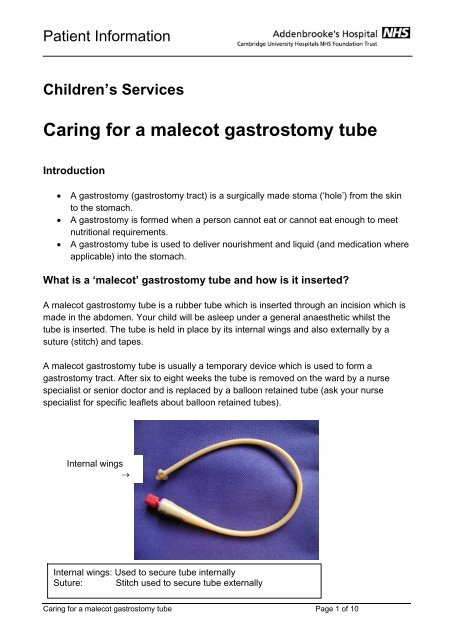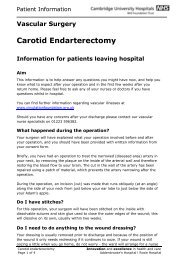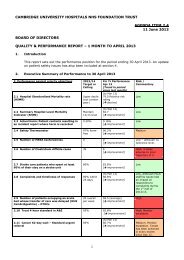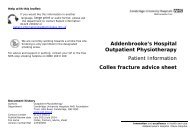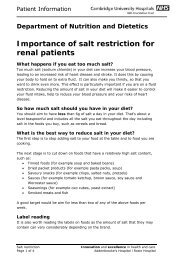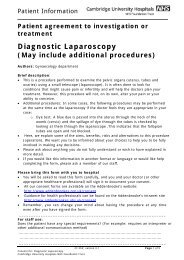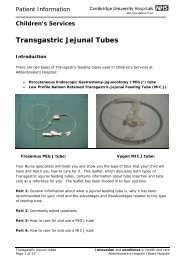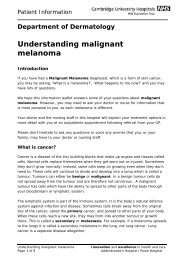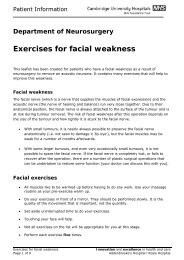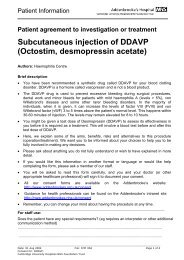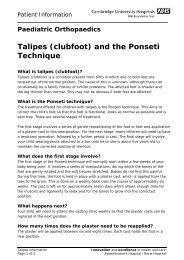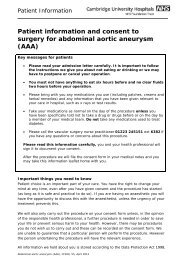Caring for a malecot gastrostomy tube - Cambridge University ...
Caring for a malecot gastrostomy tube - Cambridge University ...
Caring for a malecot gastrostomy tube - Cambridge University ...
You also want an ePaper? Increase the reach of your titles
YUMPU automatically turns print PDFs into web optimized ePapers that Google loves.
Patient In<strong>for</strong>mation<br />
Children’s Services<br />
<strong>Caring</strong> <strong>for</strong> a <strong>malecot</strong> <strong>gastrostomy</strong> <strong>tube</strong><br />
Introduction<br />
• A <strong>gastrostomy</strong> (<strong>gastrostomy</strong> tract) is a surgically made stoma (‘hole’) from the skin<br />
to the stomach.<br />
• A <strong>gastrostomy</strong> is <strong>for</strong>med when a person cannot eat or cannot eat enough to meet<br />
nutritional requirements.<br />
• A <strong>gastrostomy</strong> <strong>tube</strong> is used to deliver nourishment and liquid (and medication where<br />
applicable) into the stomach.<br />
What is a ‘<strong>malecot</strong>’ <strong>gastrostomy</strong> <strong>tube</strong> and how is it inserted?<br />
A <strong>malecot</strong> <strong>gastrostomy</strong> <strong>tube</strong> is a rubber <strong>tube</strong> which is inserted through an incision which is<br />
made in the abdomen. Your child will be asleep under a general anaesthetic whilst the<br />
<strong>tube</strong> is inserted. The <strong>tube</strong> is held in place by its internal wings and also externally by a<br />
suture (stitch) and tapes.<br />
A <strong>malecot</strong> <strong>gastrostomy</strong> <strong>tube</strong> is usually a temporary device which is used to <strong>for</strong>m a<br />
<strong>gastrostomy</strong> tract. After six to eight weeks the <strong>tube</strong> is removed on the ward by a nurse<br />
specialist or senior doctor and is replaced by a balloon retained <strong>tube</strong> (ask your nurse<br />
specialist <strong>for</strong> specific leaflets about balloon retained <strong>tube</strong>s).<br />
Internal wings<br />
→<br />
Internal wings: Used to secure <strong>tube</strong> internally<br />
Suture: Stitch used to secure <strong>tube</strong> externally<br />
<strong>Caring</strong> <strong>for</strong> a <strong>malecot</strong> <strong>gastrostomy</strong> <strong>tube</strong> Page 1 of 10
Patient In<strong>for</strong>mation<br />
Advantages of a <strong>malecot</strong> <strong>gastrostomy</strong> <strong>tube</strong><br />
• More cosmetically pleasing than a nasogastric (NG) <strong>tube</strong>.<br />
• Can be changed to a low profile <strong>gastrostomy</strong> <strong>tube</strong> with ease without the need <strong>for</strong> a<br />
further anaesthetic.<br />
Disadvantages of a <strong>malecot</strong> <strong>gastrostomy</strong> <strong>tube</strong><br />
• Requires a general anaesthetic <strong>for</strong> insertion.<br />
• Is a <strong>for</strong>eign object in the body and can there<strong>for</strong>e be associated with some minor<br />
complications, <strong>for</strong> example, infection around the site.<br />
• Recovery time post insertion is longer than that <strong>for</strong> endoscopically placed <strong>tube</strong>s.<br />
• Requires careful care/securing as it can be pulled out with relative ease.<br />
Administering feed/fluids via a <strong>malecot</strong> <strong>gastrostomy</strong> <strong>tube</strong><br />
• You <strong>gastrostomy</strong> care team (Nutrition Specialist/Nurse Specialist/Dietitian) will<br />
recommend a feeding plan suitable <strong>for</strong> your child’s needs and will provide teaching<br />
<strong>for</strong> you on how to administer it. This may be via a pump, by gravity ‘bolus’ feeds or<br />
a combination of both.<br />
• It is not necessary to check the position of the <strong>tube</strong> prior to feeding unless you are<br />
concerned that the <strong>tube</strong> does not have its normal appearance/may have become<br />
dislodged.<br />
• It is important to wash hands carefully prior to and after using any <strong>gastrostomy</strong> <strong>tube</strong>.<br />
• To maintain <strong>tube</strong> patency (prevent blockage) a flush should be administered after a<br />
feed has been given. (See section ‘flushing).<br />
• Your <strong>gastrostomy</strong> care team will teach you how to administer feeds whilst your child<br />
is in hospital.<br />
Administering medication via a <strong>gastrostomy</strong> <strong>tube</strong><br />
Administering medication correctly will avoid the <strong>gastrostomy</strong> <strong>tube</strong> becoming blocked.<br />
• Request that your child’s medication is provided in a liquid <strong>for</strong>m wherever possible.<br />
• Some liquid medications are known to be associated with <strong>tube</strong> blockages and so<br />
need to be further diluted with water (usually a 50:50 dilutation – half liquid<br />
medication, half water) be<strong>for</strong>e being administered via a <strong>gastrostomy</strong> <strong>tube</strong>. Ask a<br />
member of your <strong>gastrostomy</strong> care team if you are unsure.<br />
<strong>Caring</strong> <strong>for</strong> a <strong>malecot</strong> <strong>gastrostomy</strong> <strong>tube</strong> Page 2 of 10
Patient In<strong>for</strong>mation<br />
• If medication is only available in tablet <strong>for</strong>m, seek advice from your<br />
GP/Pharmacist/Nurse Specialist on whether tablets can be crushed / mixed with<br />
water and how to make a solution with crushed tablets. Tablet particles can lead to<br />
<strong>tube</strong> blockages.<br />
• Ensure the <strong>gastrostomy</strong> <strong>tube</strong> is flushed between drugs as well as after giving drugs.<br />
(see section ‘flushing’)<br />
• Remember to wash your hands prior to and after accessing a <strong>gastrostomy</strong> <strong>tube</strong>.<br />
General care<br />
Cleaning/Skin care<br />
• The area where the <strong>tube</strong> goes through the skin is called the stoma site. You may<br />
experience a discharge at the stoma site <strong>for</strong> the first few days (seven to ten days)<br />
until the stoma heals.<br />
• Daily care of the <strong>gastrostomy</strong> site and <strong>tube</strong> will reduce the possibility of soreness or<br />
infections. Older children should be encouraged to care <strong>for</strong> their <strong>gastrostomy</strong> sites<br />
themselves.<br />
• Always ensure that you wash your hands be<strong>for</strong>e and after caring <strong>for</strong> your child’s<br />
<strong>gastrostomy</strong> <strong>tube</strong>.<br />
• The <strong>gastrostomy</strong> site should be cleaned daily with warm soapy water.<br />
• Always avoid using cream / powders on the skin around the <strong>tube</strong> (unless otherwise<br />
advised by your care team) as they can damage the <strong>tube</strong> material and may lead to<br />
irritation of the skin and give rise to infection.<br />
• If you notice that the skin is becoming inflamed or there is discharge from the site<br />
you should contact a member of your <strong>gastrostomy</strong> care team.<br />
• To keep the <strong>tube</strong> secure it is essential that tapes are kept in place. Three lengths of<br />
tape are usually used, two which secure the <strong>tube</strong> to the skin and one additional<br />
piece of tape which prevents accidental pulling on the <strong>tube</strong>. (See section below on<br />
‘changing tapes’).<br />
Flushing<br />
Flushing the <strong>tube</strong> is essential to maintain patency, ie prevent blockages.<br />
• The <strong>gastrostomy</strong> <strong>tube</strong> should be flushed with water (sterile / cooled boiled water if<br />
the child is below one year of age).<br />
• Unless otherwise specified by your dietitian, a minimum of 20mls of water should be<br />
used <strong>for</strong> flushes after feeds. Your dietitian may advice that, in addition, you give a<br />
flush prior to feeding to ensure your child’s fluid requirements are met.<br />
• When giving drugs, it is important to flush between each medicine as well as after<br />
them to prevent precipitation (settling of the drugs) in the tubing.<br />
<strong>Caring</strong> <strong>for</strong> a <strong>malecot</strong> <strong>gastrostomy</strong> <strong>tube</strong> Page 3 of 10
Patient In<strong>for</strong>mation<br />
Replacing feeding sets<br />
• We advice that all gravity (bolus) feeding (‘giving’) sets are changed every 24 hours.<br />
Between each use the tubing should be washed with hot soapy water, rinsed then<br />
left to dry.<br />
• Continuous (‘Pump’) feeding sets should be discarded 24 hours after first use.<br />
Infection<br />
• Daily cleaning of the <strong>gastrostomy</strong> site with soapy water will help to reduce the risk<br />
of infection.<br />
• If you notice that the <strong>gastrostomy</strong> site is inflamed/red/sore/discharging, contact a<br />
member of your <strong>gastrostomy</strong> care team <strong>for</strong> advice.<br />
Changing tapes<br />
Your nurse will show you how to change the tapes prior to your discharge home. The<br />
following instructions should be followed:<br />
• The suture (stitch) which is wrapped around the <strong>malecot</strong> <strong>tube</strong> and then through the<br />
skin should not be removed. (If it falls out spontaneously extra care should be taken<br />
<strong>for</strong> example, extra taping).<br />
• The tapes which are used to secure the <strong>malecot</strong> <strong>tube</strong> should be changed whenever<br />
they are coming off or are soiled.<br />
• It is important to ensure that the <strong>tube</strong> is not pulled any more than necessary during<br />
tape changes as this can lead to accidental dislodgement.<br />
• Wash hands prior to and after changing tapes.<br />
• Cut the lengths of new tape prior to removing the old ones.<br />
• Unless your child has an allergy, a plaster remover wipe (<strong>for</strong> example, Zoff) should<br />
be used to help detach the tape from the skin / <strong>tube</strong>.<br />
• Once the tapes are all off, clean around the stoma site with warm soapy water.<br />
• Pat the skin dry so that the new tapes will stick effectively.<br />
• Tapes should be applied in such a way that the <strong>tube</strong> stands erect from the skin.<br />
This ensures that a round stoma is created (if the <strong>tube</strong> is taped flat onto the skin an<br />
oval hole will be created which can lead to leakage).<br />
Common questions<br />
Can I/my child bath/shower?<br />
Yes, once the site if fully healed (usually about seven days after insertion) you/your child<br />
<strong>Caring</strong> <strong>for</strong> a <strong>malecot</strong> <strong>gastrostomy</strong> <strong>tube</strong> Page 4 of 10
Patient In<strong>for</strong>mation<br />
can bath/shower as normal. Always ensure that the <strong>tube</strong> end is closed. Dry the area<br />
thoroughly afterwards.<br />
Where do I get the equipment and supplies?<br />
We will provide you with initial supplies (usually enough to last <strong>for</strong> one week) and a spare<br />
<strong>tube</strong> to use in case the <strong>malecot</strong> <strong>tube</strong> falls out. You will receive further supplies from your<br />
community healthcare team; some areas use a home delivery service. If you have any<br />
problems getting supplies at home please ring your nurse specialist who will be able to<br />
help you. You should remember to order new supplies in good time be<strong>for</strong>e you run out and<br />
only use equipment <strong>for</strong> the length of time specified by the manufacturer.<br />
Will I/my child be able to go to school?<br />
You/Your child should be able to go to school as normal. Staff at the school can be taught<br />
what to do if the device falls out and spare supplies should also be kept at the school <strong>for</strong><br />
emergency use.<br />
Can we go on holiday?<br />
• It is fine to travel (with your child) but it is advised that you discuss travel plans with<br />
you doctor / <strong>gastrostomy</strong> care team. It may be helpful, particularly if your child has<br />
complex needs, to take a letter with you from your care team which can help you if<br />
you need to seek medical advice whilst on holiday. In addition letters from your care<br />
team can be useful to prevent any problems with airport security when you are<br />
travelling with ‘medical equipment’.<br />
• Remember to take extra supplies with you and to pack at least some of these in<br />
your hand luggage in case your main luggage goes astray.<br />
• Use a large dressing to avoid getting sand near the stoma site as this can irritate<br />
the skin.<br />
• If you are travelling abroad you may wish to contact HALF PINNT (‘Patients on<br />
Intravenous and Nasogastric Nutrition Therapy’). They can provide you with useful<br />
in<strong>for</strong>mation re travelling with a child who has a <strong>gastrostomy</strong> <strong>tube</strong> including travel<br />
insurance advice. (See contact details at end of leaflet).<br />
• Your home delivery company will also offer practical advice.<br />
What happens when the <strong>malecot</strong> <strong>tube</strong> is removed?<br />
• Be<strong>for</strong>e your child is discharged your Nurse Specialist will arrange a date <strong>for</strong> you to<br />
return to the ward <strong>for</strong> change of <strong>gastrostomy</strong> <strong>tube</strong>.<br />
• It is advisable that you/your child is not fed <strong>for</strong> two hours prior to your appointment<br />
time as this prevents feed leaking out when the <strong>tube</strong> is removed.<br />
<strong>Caring</strong> <strong>for</strong> a <strong>malecot</strong> <strong>gastrostomy</strong> <strong>tube</strong> Page 5 of 10
Patient In<strong>for</strong>mation<br />
• We also advise that you take/give your child some painkillers (<strong>for</strong> example,<br />
paracetamol) prior to leaving home <strong>for</strong> the appointment.<br />
• On arrival your Nurse Specialist will meet you and discuss the course of events.<br />
The Nurse Specialist will remove the <strong>malecot</strong> <strong>tube</strong> on the ward; this is usually<br />
uncom<strong>for</strong>table rather than painful if paracetamol has been given earlier.<br />
• Once the <strong>malecot</strong> <strong>tube</strong> is removed the Nurse Specialist will measure the length of<br />
the <strong>gastrostomy</strong> tract with a special device and will then insert an appropriately<br />
sized low profile balloon retained <strong>gastrostomy</strong> <strong>tube</strong> (mic-key button).<br />
• Be<strong>for</strong>e you go home your Nurse Specialist will teach you how to care <strong>for</strong> the new<br />
<strong>tube</strong> and will arrange <strong>for</strong> any changes to your home supplies to be made.<br />
Problem solving<br />
Tube falls out prior to its planned removal<br />
If a <strong>gastrostomy</strong> <strong>tube</strong> falls out the tract can close within one to two hours. The following<br />
action plan should there<strong>for</strong>e be instigated immediately by either a<br />
nurse/doctor/parent/carer to prevent complications.<br />
1. Open MIC-G <strong>tube</strong> packet.<br />
2. Check balloon by inserting 5mls of sterile (cooled boiled) water into the balloon and<br />
then removing the water again. Also check that the round clear disk slides up and<br />
down the <strong>tube</strong> (it will be stiff as it is new).<br />
3. Put small amount of KY jelly onto the end of the MIC G <strong>tube</strong>.<br />
4. Gently push the MIC G <strong>tube</strong> into the <strong>gastrostomy</strong> tract.<br />
5. Once the <strong>tube</strong> is inserted 4cms (markings are available on the side of the <strong>tube</strong>)<br />
inflate the balloon using 5mls of sterile water (the balloon port is green).<br />
6. Gently pull back on the <strong>tube</strong> until resistance is felt.<br />
7. Once resistance is felt, slide the round clear disk down to meet the skin to prevent<br />
the <strong>tube</strong> moving about in the tract.<br />
8. Aspirate a few mls of stomach contents via the clear / white port and check on pH<br />
strip to ensure <strong>tube</strong> is definitely inside the stomach (acid pH is one to five) or on<br />
blue litmus paper (turns pink). Do not use the <strong>tube</strong> if you are unsure of its position.<br />
9. Once in place the MIC G <strong>tube</strong> can be used <strong>for</strong> feeding/medications (<strong>for</strong> up to three<br />
months).<br />
10. In<strong>for</strong>m your Nurse Specialist so that arrangements can be made <strong>for</strong> a low profile<br />
<strong>gastrostomy</strong> <strong>tube</strong> (button) to be inserted.<br />
Tube blockage<br />
To prevent <strong>tube</strong> blockage the <strong>tube</strong> should be flushed with water after giving<br />
feeds/medication (see section ‘Flushing’). Always ensure medications are being<br />
<strong>Caring</strong> <strong>for</strong> a <strong>malecot</strong> <strong>gastrostomy</strong> <strong>tube</strong> Page 6 of 10
Patient In<strong>for</strong>mation<br />
administered in a way that limits the chances of <strong>tube</strong> blockage (see section on<br />
‘administering medication’).<br />
If the <strong>tube</strong> does block you may try the following. If unsuccessful on the first step, try the<br />
next:<br />
1. Ensure all clamps are open and the <strong>tube</strong> is not kinked.<br />
2. Try to flush using a pumping action with the plunger on the syringe.<br />
3. Connect a 50ml syringe to the end of the <strong>tube</strong> and try to draw back (‘aspirate’).<br />
4. Massage the <strong>tube</strong> around the area of blockage if it is obviously visible.<br />
5. Mix a solution of sodium bicarbonate (baking soda).<br />
• Mix half a teaspoon of sodium bicarbonate (baking soda) with 30mls of boiling<br />
water.<br />
• Leave this to cool to a warm temperature then use a syringe to flush this solution<br />
down the <strong>tube</strong>.<br />
• Leave the solution in the tubing <strong>for</strong> at least two hours (can be left overnight) then<br />
flush it through with 20mls of water.<br />
• If you do not have any sodium bicarbonate, try soda water or pineapple juice.<br />
6. Contact a member of your <strong>gastrostomy</strong> care team.<br />
Important: Never use excessive <strong>for</strong>ce and never attempt to unblock the <strong>tube</strong> by<br />
inserting objects down it.<br />
Discharge observed from stoma site<br />
It is usual to experience a discharge at the stoma site until the stoma heals (usually 7-10<br />
days after placement). It is important to clean the area carefully during this time. If the<br />
discharge is spoiling clothing a small ‘key hole’ dressing can be applied but should be<br />
changed regularly / removed when no longer needed.<br />
If you notice any discharge/odour from the stoma site after the <strong>tube</strong>s initial insertion you<br />
should contact a member of your <strong>gastrostomy</strong> care team.<br />
Feed leakage from stoma site<br />
• If feed is observed coming from the stoma site you should check that the tubing is<br />
being held securely next to the skin.<br />
• Leakage from the stoma site can occur because the stomach is too full/contains<br />
gas. (See section on Venting). If you notice feed leaking out around the stoma site<br />
you should contact your dietitian to discuss changing feeding regimes, <strong>for</strong> example<br />
decreasing the flow rate.<br />
• If the problem persists you should contact a member of your <strong>gastrostomy</strong> care team<br />
<strong>for</strong> advice.<br />
<strong>Caring</strong> <strong>for</strong> a <strong>malecot</strong> <strong>gastrostomy</strong> <strong>tube</strong> Page 7 of 10
Patient In<strong>for</strong>mation<br />
Stomach is swollen and/or feels hard: ‘Venting’ (or ‘Decompression’)<br />
Sore skin<br />
• Some children suffer from trapped wind. This gas can be released by<br />
decompressing the stomach via the <strong>gastrostomy</strong> <strong>tube</strong>.<br />
• To decompress the stomach attach a syringe to the <strong>tube</strong> and aspirate the gas.<br />
• Redness or soreness around the skin and stoma may be the result of gastric<br />
leakage.<br />
• Clean and dry the area frequently.<br />
• Call your community nurse if the stoma is persistently red and sore, the stoma emits<br />
an odour, the surrounding skin is swollen, you observe pus or there is bleeding from<br />
the site.<br />
Overgranulation<br />
Granulation tissue is the result of the body trying to repair itself. You may recognise<br />
overgranulation as a clear brownish discharge and occasional bleeding or as a pinkish<br />
raised tissue. The tissue may proliferate and require treatment. If bleeding occurs or a<br />
large amount of tissue builds up, contact a member of your <strong>gastrostomy</strong> care team <strong>for</strong><br />
advice.<br />
When sickness and/or has stomach cramps occur:<br />
• See section on ‘Venting/Decompression’.<br />
• You may need to slow the rate of feeding. Contact your dietitian if this problem<br />
continues.<br />
• The feed may be too cold, let the feed reach room temperature be<strong>for</strong>e administering<br />
it.<br />
When diarrhoea occurs:<br />
• The rate of feeding may need to be slowed down.<br />
• If diarrhoea continues contact your doctor.<br />
When vomiting occurs:<br />
• See section on ‘Venting/Decompression’.<br />
• You may need to slow the rate of feeding.<br />
• Always check expiry dates of feed.<br />
<strong>Caring</strong> <strong>for</strong> a <strong>malecot</strong> <strong>gastrostomy</strong> <strong>tube</strong> Page 8 of 10
Patient In<strong>for</strong>mation<br />
• The feed may be too cold. Let the feed reach room temperature be<strong>for</strong>e<br />
administering it.<br />
• If your child continues to vomit and the above simple steps have not helped you<br />
should contact your doctor.<br />
Details of your/your child’s <strong>malecot</strong> <strong>gastrostomy</strong> <strong>tube</strong><br />
Make of <strong>tube</strong>:<br />
French size (Fr):<br />
Length of <strong>tube</strong> (cms):<br />
Contact numbers <strong>for</strong> your <strong>gastrostomy</strong> care team<br />
Position<br />
Nurse Specialist<br />
Nutrition Sister<br />
Dietitian<br />
Name Contact number<br />
Community Paediatric Nurse<br />
Home Delivery Company<br />
HALF PINNT (‘Patients on<br />
Intravenous and Naso<br />
gastric Nutrition Therapy’)<br />
01582 765238<br />
<strong>Caring</strong> <strong>for</strong> a <strong>malecot</strong> <strong>gastrostomy</strong> <strong>tube</strong> Page 9 of 10
Patient In<strong>for</strong>mation<br />
Please ask if you require this in<strong>for</strong>mation in other languages, large print or audio <strong>for</strong>mat:<br />
01223 216032 or patient.in<strong>for</strong>mation@addenbrookes.nhs.uk<br />
Potete chiedere di ottenere queste in<strong>for</strong>mazioni in altre lingue, in stampato grande o in<br />
audiocassette.<br />
Italian<br />
Cantonese<br />
Gujarati<br />
Kurdish<br />
Urdu<br />
Addenbrooke’s is smoke-free. Please do not smoke anywhere on the site.<br />
For advice on quitting, contact your GP or the NHS smoking helpline free, 0800<br />
169 0 169<br />
Document history<br />
Authors Andrea Jordan<br />
Department Department of Paediatric Surgery, Box 267, Addenbrooke’s Hospital, <strong>Cambridge</strong><br />
<strong>University</strong> Hospitals NHS Foundation Trust, Hills Road, <strong>Cambridge</strong>, CB2 2QQ<br />
www.addenbrookes.org.uk<br />
Contact number 01223 245151<br />
Published August 2006<br />
Review date August 2008<br />
File name Malecot_<strong>tube</strong>.doc<br />
Version number 1<br />
Ref PIN 231<br />
<strong>Caring</strong> <strong>for</strong> a <strong>malecot</strong> <strong>gastrostomy</strong> <strong>tube</strong> Page 10 of 10


